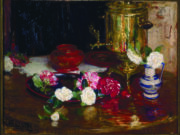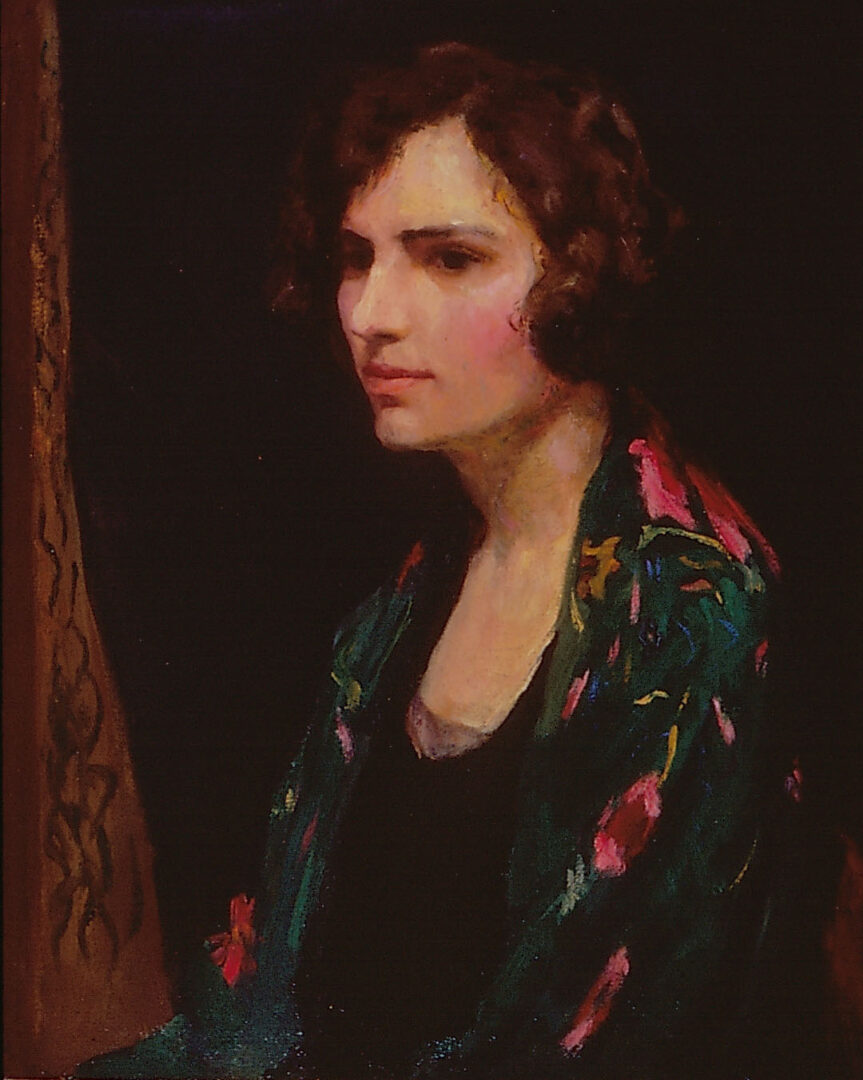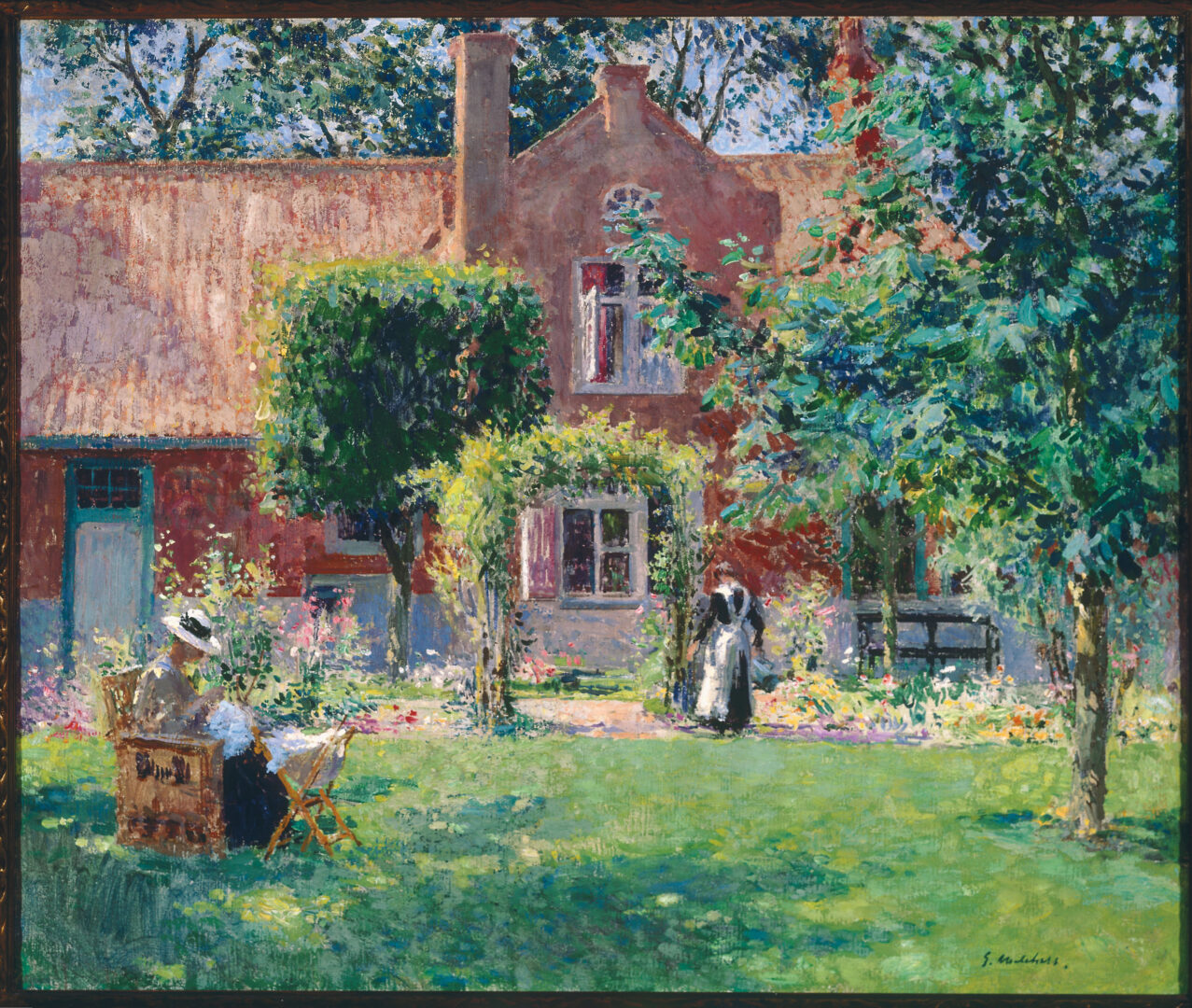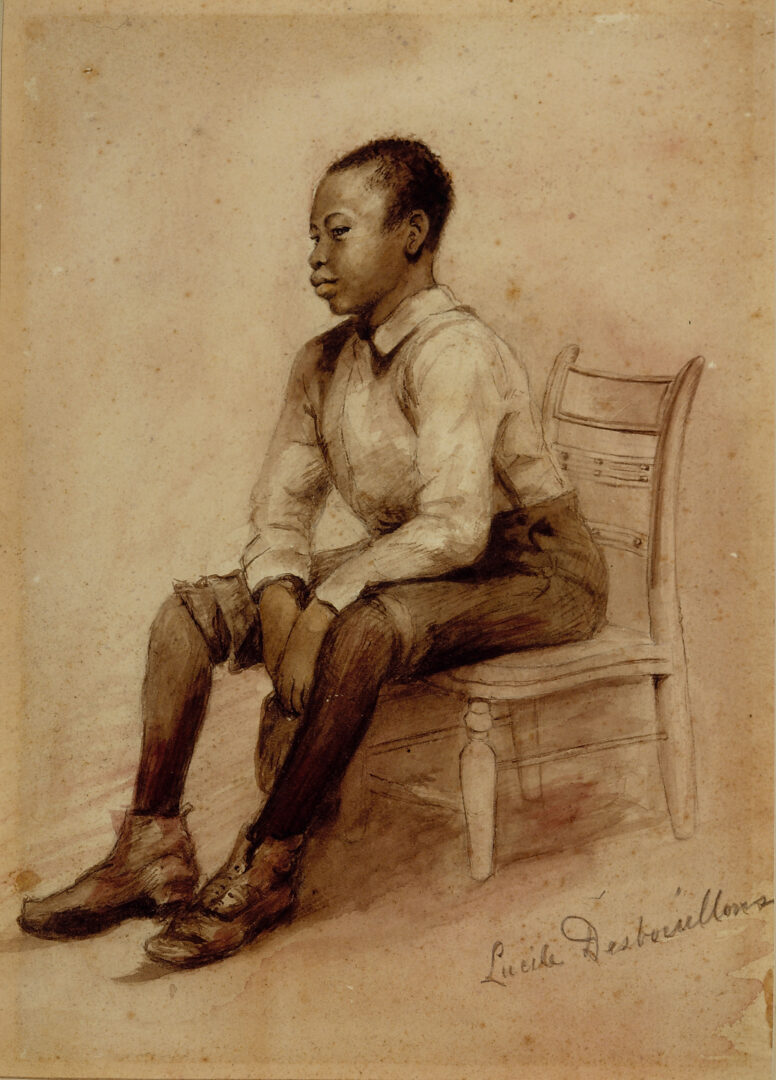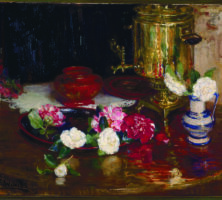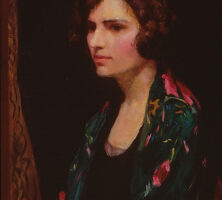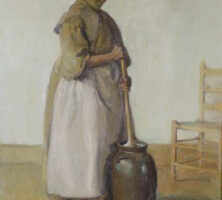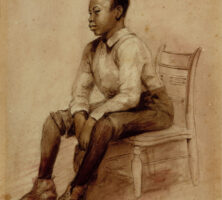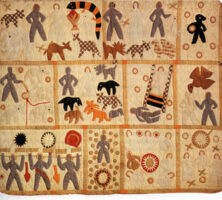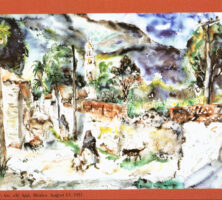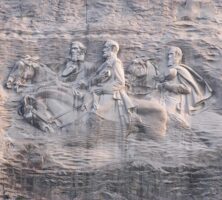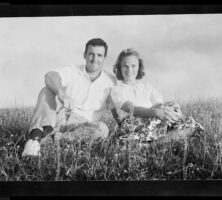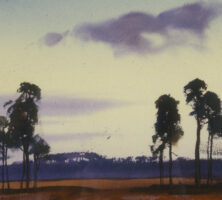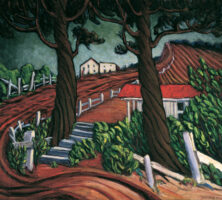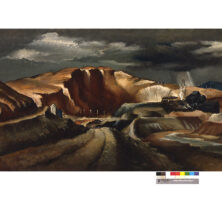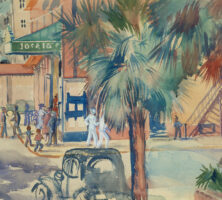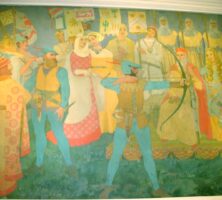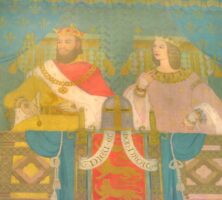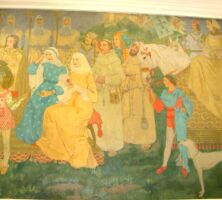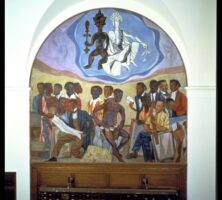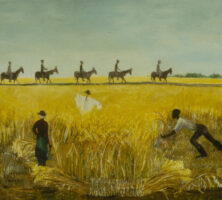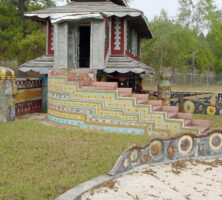The period from 1895 to 1960 in Georgia was characterized by a widening support for and interest in the state’s art and artists.
Sparked by the influence of the art exhibition shown at the Cotton States and International Exposition in 1895, as well as by the establishment of museums early in the twentieth century, this period of artistic development in the state reached its height during the Great Depression years of the 1930s and early 1940s. Growing out of localized artistic efforts and traditions in Atlanta and Savannah, this watershed era also resulted from such national influences as the emergence of the American Scene aesthetic, with its emphasis on regional subject matter, and opportunities proffered to artists by the New Deal policies of the federal government. In the years following World War II (1941-45), Georgia’s artists, both formally trained and self-taught, moved toward a more personal and intimate art expressed in the language of abstraction.
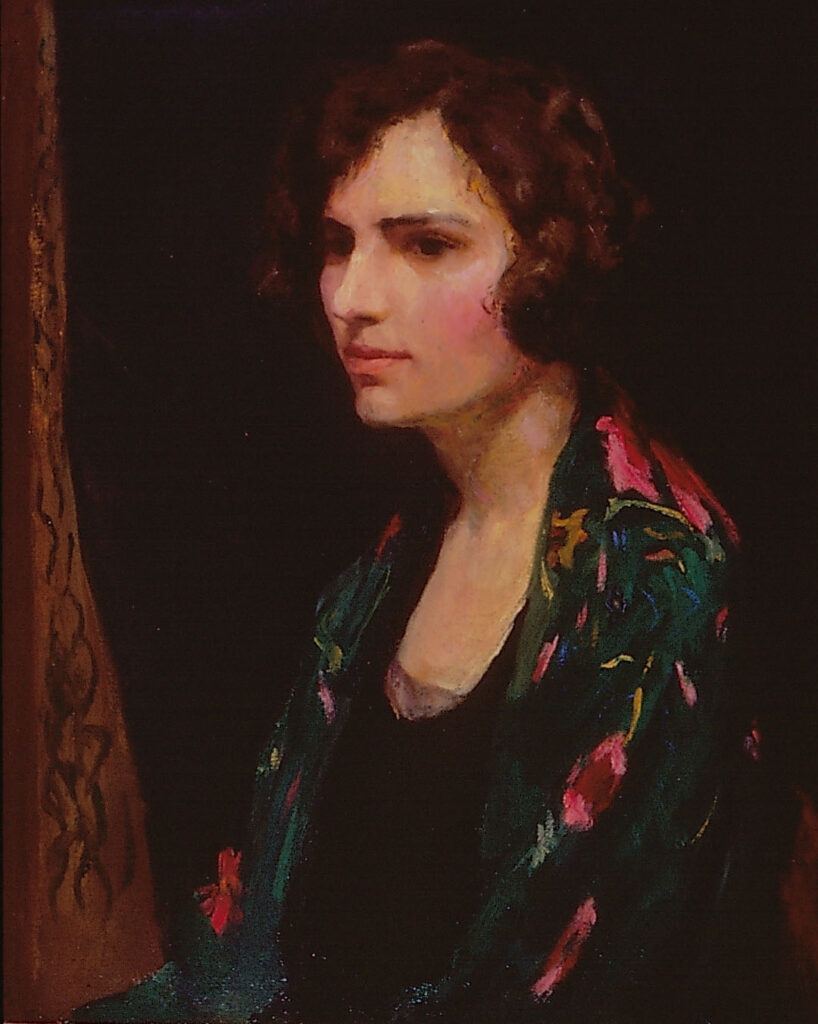
From 1895 through the 1920s
The art communities of Atlanta and Savannah flourished around the turn of the twentieth century. In Atlanta the 1895 Cotton States and International Exposition, a sprawling fair held in Piedmont Park, featured a wide range of national and international art. The establishment of the Emory University Museum (later the Michael C. Carlos Museum of Art) and the High Museum of Art, as well as an art school, further encouraged the growth of the arts in the city. Meanwhile, the older artistic community in Savannah thrived with the expansion of the Telfair Academy of Arts and Sciences (later Telfair Museums) and the influx of trained artists into the city.
Atlanta
Although it was not considered an American art center at the time of the Cotton States exposition in 1895, Atlanta had hosted yearly Piedmont Expositions since 1887, as well as a number of highly publicized loan exhibitions. The Cotton States exposition, however, essentially announced the city’s ambition to make the visual arts an important part of Atlanta culture and marked a turning point in the history of art in Georgia. The display of approximately 1,000 paintings, drawings, prints, and sculptures by Americans and Europeans was arranged by Horace Bradley, head of the fine arts department of the exposition, and exhibited in the city’s Fine Arts Building, a Greek revival building reminiscent of grand European architecture.
Works by an array of leading American artists, including Cecilia Beaux, Thomas Eakins, Theodore Robinson, and Worthington Whittredge, represented a variety of nineteenth-century tastes in painting, including the Hudson River School, figure and portrait painting, and American impressionism. Indeed, impressionist Robinson exhibited twenty-seven works, more than any other artist in the fine arts section. American sculptors who showed works included the prominent New York artists Daniel Chester French and Frederick MacMonnies. Drawings on loan to the exhibition from the Century Company in New York included works by E. H. Blashfield and Kenyon Cox, both known for their beautifully drawn figures, and Howard Pyle, revered for his book illustrations. Frederick Keppeland Company, a gallery in New York that promoted the revival of etching as an original art form, loaned prints by pioneers and leaders of the etching revival movement, including city and landscape views by Seymour Haden, Charles Meryon, Joseph Pennell, and James Abbott McNeil Whistler.
The exposition seemed to spur the development of art and art activities in Atlanta, already a city of numerous studio art classes, small art schools, and exhibitions. Indeed, many enthusiasts in the capital city saw art as a great refining influence upon its citizens. By 1900 there were renewed calls for a larger, permanent art school in Atlanta, one that would both contribute significantly to the training of artists in the South and encourage local support. Most artists in Atlanta and the state who were determined to pursue professional careers during this period traveled to Boston, Massachusetts; Chicago, Illinois; New York City; Philadelphia, Pennsylvania; or European cities to further their training. Finally, with great enthusiasm for promoting an aesthetic culture in the city, the Atlanta Art Association was officially established in 1905. Exhibitions would be an important part of its activities, and its end purpose was to found an art museum and art school.
Around 1900 painting in Atlanta was still dominated by portraits and still lifes, though landscape had become a major theme in southern painting by this time. Leading artists of these years included the portraitist and illustrator Adelaide Everhart, a North Carolina native who trained at the Cincinnati Art Academy and with William Merritt Chase and others at the Art Students League of New York. Painter Hal Alexander Courtney Morrison, born in Canada and trained as a physician at Harvard University in Cambridge, Massachusetts, studied art in Europe and executed skilled scenes of southern life and paintings of still life, especially of fish and game. He lived in Atlanta until 1918, teaching painting in his studio.
Lucy M. Thompson and Lucy May Stanton both painted portrait miniatures, that is, very small portraits painted on ivory. Born and reared in Atlanta, Stanton returned to the city in 1898 after studying in Paris, France, at the Ecole de la Grande Chaumière, the Académie Colarossi, and the Sorbonne, as well as, reportedly, with the painter Whistler. She also studied art in New Orleans, Louisiana. After her return to Atlanta, Stanton lived off and on in Athens, Greece; Paris; New York; and Boston. She gained an international reputation for her portrait miniatures and exhibited them in Chicago; London, England; New York; Paris; and Philadelphia. By around 1906 she had developed a new technique of miniature painting called “puddling,” which involved the application of watercolors on ivory in a loose, impressionistic, watery manner very different from the traditional fashion of stippling (dotting), which required either small touches of paint or hatched strokes on the ivory. Stanton’s Self Portrait: The Silver Goblet (1912–15) offers one example of her puddling technique. Her innovative, expanded range of subjects included portraits of everyday workers, including African Americans and southern mountaineers, as well as scenes of Black southerners at work and rest, as seen in her Churning (1910) and Working on the Street (1921), which is housed at Emory University’s Robert W. Woodruff Library. Willie M. Chambers of Atlanta, an untrained painter who owned a seamstress business, painted still lifes and portraits when she visited relatives in Montezuma in south Georgia.
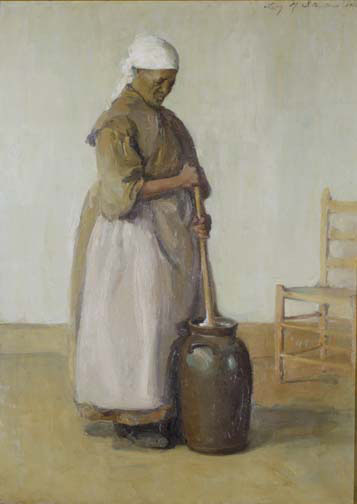
The professional and academically trained sculptor and art critic Orion Frazee, well known in Atlanta for his portrait busts and for his death masks of such southern heroes as Jefferson Davis, left the city in 1894. After his departure, little sculptural activity seems to have taken place in the city until the arrival of Joshua A. Brockett, an African American who had studied sculpture in Boston and taught theology at Morris Brown College in Atlanta, where he also made portrait busts and other works. In 1915 at Stone Mountain, the academically trained and nationally known sculptor Gutzon Borglum, who later created the Mount Rushmore Memorial in South Dakota, began preliminary work on his much-publicized memorial to the Confederacy. Borglum envisioned an expansive relief of Confederate heroes chiseled on the face of the monumental granite hill, which rises a thousand feet into the air east of Atlanta.
Savannah
Though Atlanta offered Georgians opportunities in the early years of the twentieth century for studying and seeing art, Savannah had the richest legacy among cities in the state of providing access to and supporting art. Interest in art and in artists working in that city existed in Savannah long before the founding of Atlanta, and that interest was often closely aligned with art in Charleston, South Carolina, further up the eastern coast.
In the late nineteenth century, the center of art activities in Savannah was the Telfair Academy of Arts and Sciences, which was founded in 1875 and opened in 1886. The German-born portraitist and history painter Carl Brandt was the academy’s first director. After Brandt’s death, the Detroit-born naturalistic landscape, genre, and portrait painter Gari Melchers advised on works for the museum from 1906 to 1916. Melchers’s wide-ranging experience included study at the Royal Academy at Dusseldorf in Germany and the Ecole des Beaux-Arts in Paris, as well as exhibitions at the Paris Salon, the National Academy of Design in New York, and several other art centers in America and Europe, where he won numerous awards. Married in 1903 to painter Corinne Lawton Mackall of Savannah, Melchers began painting open-air scenes in an impressionistic style with loose, sketchy brush strokes during the 1900s, including The Unpretentious Gardener (ca. 1905) and The Plantation Home. As a consequence, under Melchers’s lead the Telfair acquired numerous paintings by American impressionists as well as those of later artists working in more aggressive, modern styles.
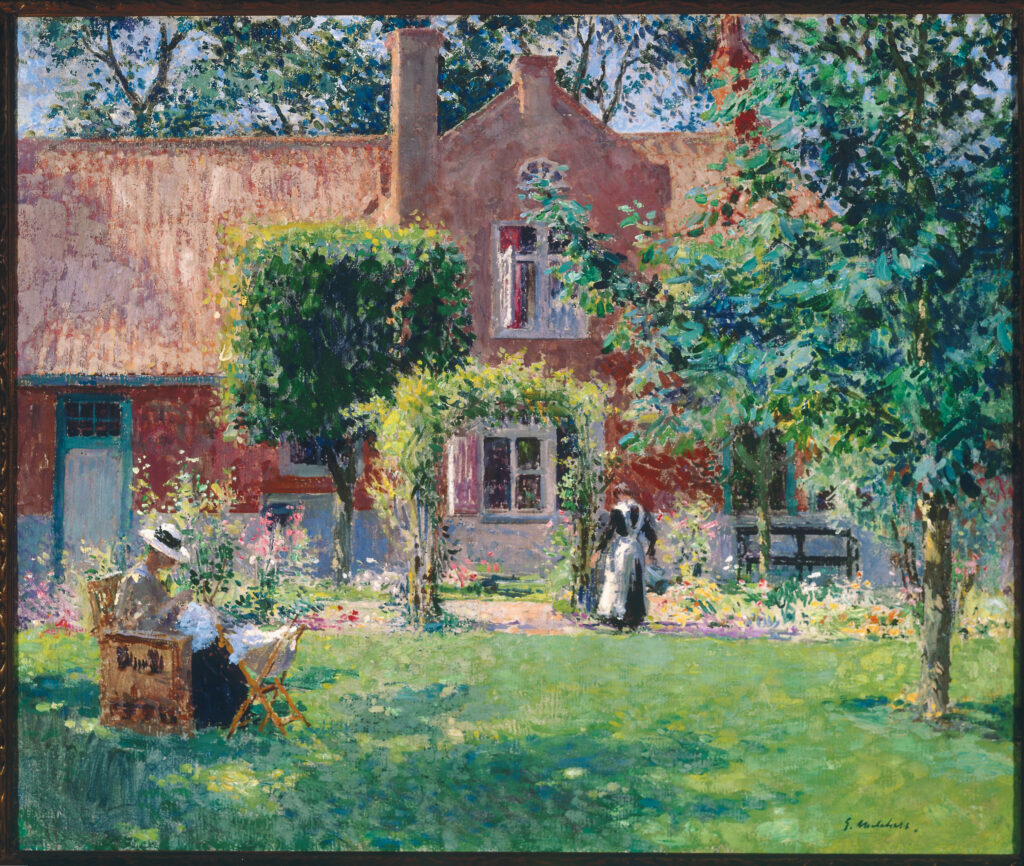
From 1908 the Telfair also exhibited shows circulated by the American Federation of Arts (AFA), an exhibition service in New York. In 1911, for example, the AFA sponsored a Telfair exhibition of paintings by American artists including impressionists William Merritt Chase and Childe Hassam, the venerable portraitist and influential teacher Robert Henri, and impressionist-inspired William Glackens and Ernest Lawson. The latter three belonged to the rebellious group of early twentieth-century artists in New York known as “The Eight,” who opposed the more conservative, academic tastes of the National Academy of Design. The AFA also sponsored a Telfair exhibition of the works of George Bellows, the ebullient American realist painter.
Many talented painters lived in Savannah during the early years of the twentieth century. Emma Cheves Wilkins, known for her elegant and sensitively painted still lifes and landscapes, as well as more academic portraits, studied with Brandt at the Telfair and also trained at the Colarossi Academy in Paris. Her Playing with Reds (Camellias) (ca. 1931) is housed at the Telfair Museum of Art. Other painters of the time included the cousins Mary Hope Cabaniss and Lila Marguerite Cabaniss; Valerie Chisholm; impressionist landscapist Mary Comer Lane, who was instrumental in founding the Savannah Art Club; the watercolorist Christopher Patrick Hussey Murphy and his wife, Lucile Desbouillons; and the painter Hattie Saussy.
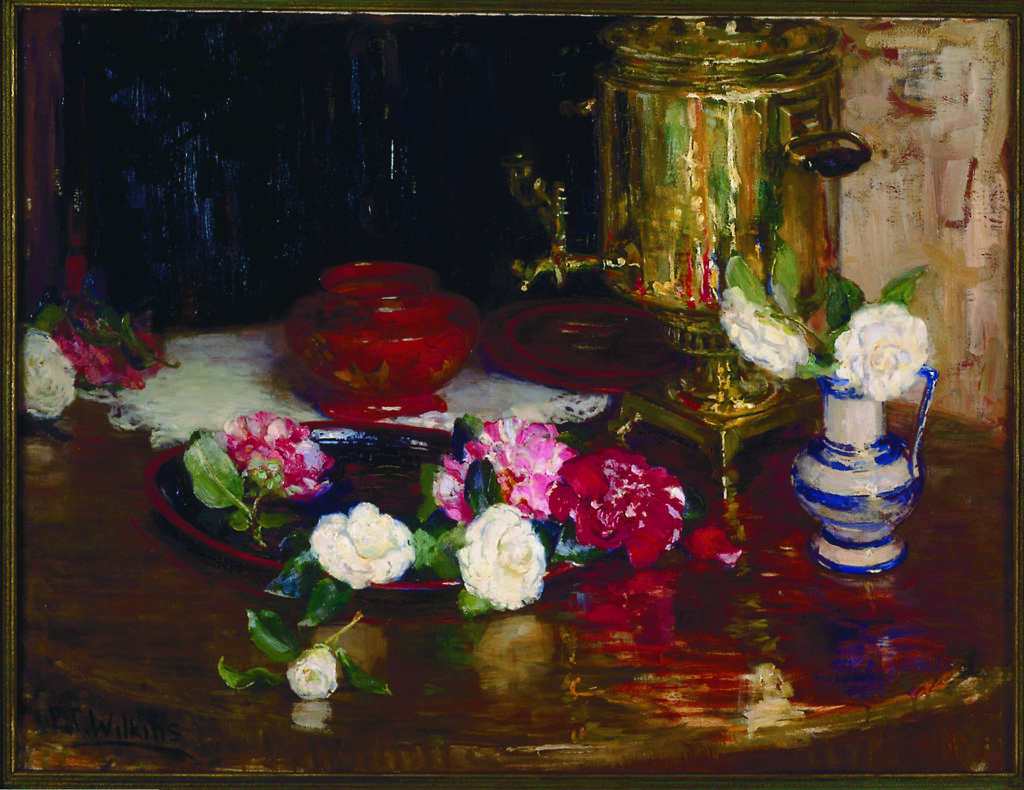
Landscape and still-life painter Lila Cabaniss, born in Savannah, studied at numerous institutions, including the Art Students League and Columbia University in New York City and Syracuse University in New York State. She exhibited widely and in 1915 started an art curriculum in the Chatham County school system. Saussy had first trained with Lila Cabaniss and Emma Wilkins in Savannah; she continued her study in New York City at the New York School of Fine and Applied Art in 1908-9 and at the National Academy of Design and the Art Students League in 1911-12. At the Art Students League, she studied under George Bridgman, Frank Vincent DuMond, Eliot O’Hara, and Eugene Speicher. After completing her studies, Saussy traveled to Europe to expand her knowledge further, visiting museums and sketching. When World War I began in Europe in 1914, she returned to America and in the 1920s settled in Savannah. A painter of vivid still lifes and portraits, as well as energetic, sun-dappled landscapes, she is said to have been inspired in her light-filled canvases by the American impressionist paintings at the Telfair.
Christopher P. H. Murphy, who trained with Eben Comins in 1915 at the popular artistic community of Gloucester, Massachusetts, and was a friend of New York etcher Joseph Pennell, painted a body of watercolors and oils of local scenes in Savannah and elsewhere in America. His scenes were dominated by elegant views of architecture and exuded strong atmospheric effects, as seen in his DeSoto Hotel on Fire (ca. 1926-30). Lucile Desbouillons Murphy, his wife, studied at the Telfair with Brandt as well as in Paris, where she registered as an art student in 1895 along with Emma Wilkins at the studio of Gustave Courtois. She excelled at drawings and watercolors, executing her work with easy, fluid strokes, as seen in her Black Man Seated on a Chair (ca. 1910), which is housed at the Morris Museum of Art in Augusta.
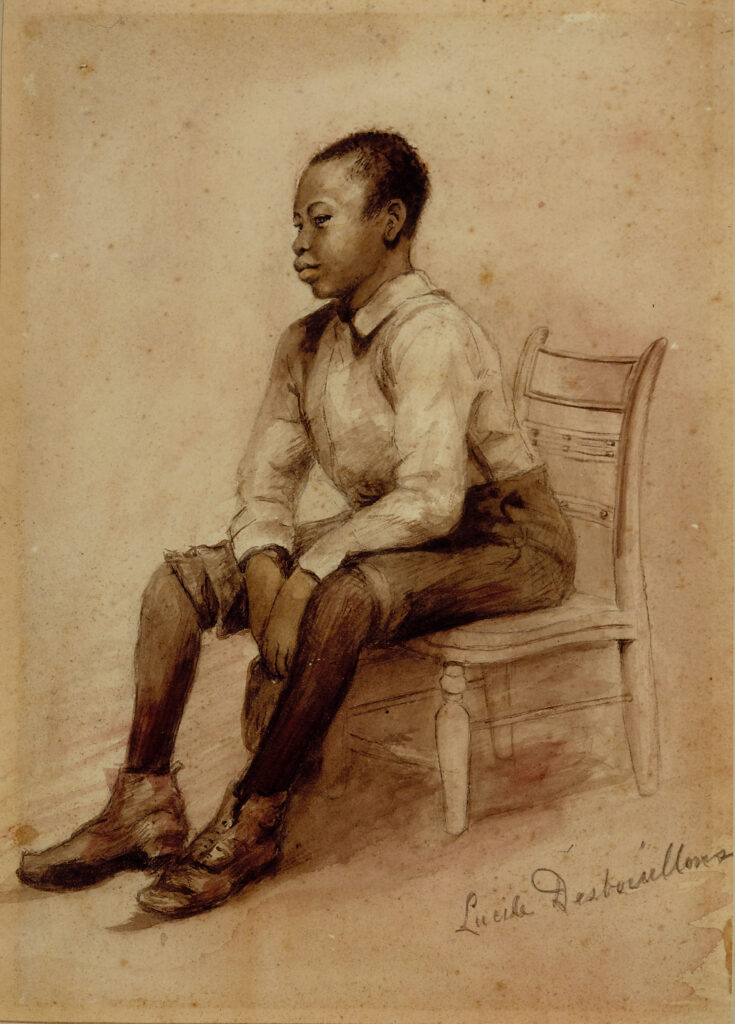
Savannah has attracted artists since its founding, and the early years of the twentieth century were no exception. The prolific and widely exhibited painter William Posey Silva was born in Savannah and became active in California and the South. During the summers from 1900 to 1905, he studied art composition with Arthur Wesley Dow in Ipswich, Massachusetts. Shortly afterward, while in his late forties, he decided to pursue art full-time and studied figure drawing at the Académie Julian in Paris under J. P. Laurens and Henri Royer, as well as landscape painting with Chauncey F. Ryder in Etaples, France. Returning to the South in 1909, he spent a year touring and painting the region. In 1913 he settled in California. After 1915 Silva traveled extensively in the South, including Georgia, where the varied landscape inspired such impressionistic paintings of the countryside shrouded in mist as his Georgia Pines at Sunset. His ethereal landscape paintings are reminiscent of the oils by Alexander John Drysdale, an impressionist painter born in Marietta and a resident of New Orleans, whose early-twentieth-century paintings of bayous are suffused with washes of thinned oils.
Other artists who visited the area included the nationally known sculptor Daniel Chester French, who executed in 1910 a public monument to James Edward Oglethorpe, the British founder of the Georgia colony. In 1903 the New York painter Walt Kuhn visited Savannah. In the winters of 1914 and 1915, impressionist painter Harry L. Hoffman, from the Old Lyme art colony in Connecticut, also visited Savannah. The Ohio-born photographer Edgerton Chester Garvin, active from 1909 to 1947, traveled in Georgia and shot scenes along the coast and inland, including Savannah, Brunswick, and Augusta. He worked in a romantic, atmospheric approach representative of pictorialist photographers of the early years of the twentieth century. In other developments, the Camera Club of Savannah was founded at the turn of the century.
Other Cities
In Athens, the site of the University of Georgia and a wellspring of art and culture, the engaging works of African American quilt maker Harriet Powers gained the support in the early 1890s of Oneita Virginia (Jennie) Smith, an artist trained in Baltimore, Maryland; New York; and Paris, who headed the art department at the Lucy Cobb Institute for fifty years. Powers, a formerly enslaved woman living near Athens, made highly admired biblical and folktale story quilts that are included in several major American collections, including the Museum of Fine Arts in Boston, which houses her Pictorial Quilt (1895-98). Beginning in 1902, the portraitist and miniaturist Lucy May Stanton lived intermittently in Athens. She kept a studio there from about 1908 until she died in 1931. Stanton also co-organized traveling art exhibitions in Athens and generally helped to promote an appreciation of art in the area.
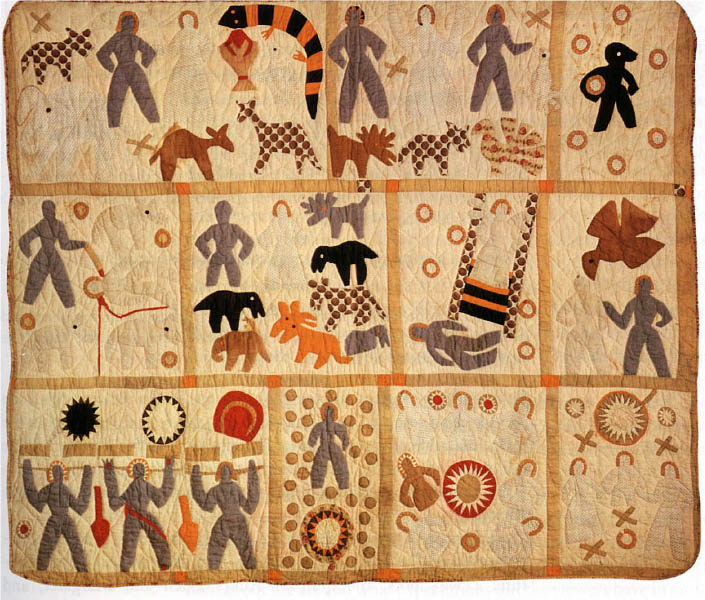
Painter Rosetta Raulston Rivers in Macon made oils, watercolors, and designs for textiles and wallpapers and taught and headed the art department at Wesleyan College. She studied at the Art Students League and the School of the Art Institute of Chicago, as well as with painter Charles Hawthorne and others.
Joseph Cranston Jones of Augusta became revered among collectors for his portrait silhouettes.
Growth in the State
Following the concerted efforts made in the early years of the twentieth century to establish art as an integral part of the state’s culture, the late 1910s and the 1920s were pivotal years in Georgia as more institutions devoted to art were founded and an appreciation for the distinctiveness of the state’s land and cultures deepened. In 1919 the Emory University Museum was founded at Emory University in Atlanta, and the following year that museum, through Professor William Shelton, acquired important Egyptian antiquities that now form the core of the permanent collection. After more than twenty years of planning by the Atlanta Art Association, an art museum and permanent art school, the High Museum and the School of Art, were finally founded in 1926. Both institutions were supported by the great promotional skills of several Atlantans, including the American art collector J. J. Haverty. Mrs. Joseph Madison High donated her former residence on Peachtree Street to the city of Atlanta for an art museum; the upstairs was devoted to the art school.
Around 1927 the Art School of the High Museum of Art attracted young Atlanta-born artist Lamar Baker, who attended a charcoal-drawing class taught by Cornelia Cunningham, who had trained at Cooper Union in New York. A short time later Baker attended the school again, with Ben Shute as instructor, by which time the curriculum had, according to Baker, become more ambitious. That decade he also studied at the Sketch Club in Atlanta, where he took a life-drawing class with students in architecture at the Georgia Institute of Technology and with architects, commercial artists, and students who had studied art in the North. A group of these artists formed the Studio Club, and members included Harold Bush-Brown, head of the department of architecture at the Georgia Institute of Technology, and his wife, Marjorie Conant Bush-Brown, a painter trained in Boston. Elsewhere in the 1920s, a fine arts department was established at Emory University.
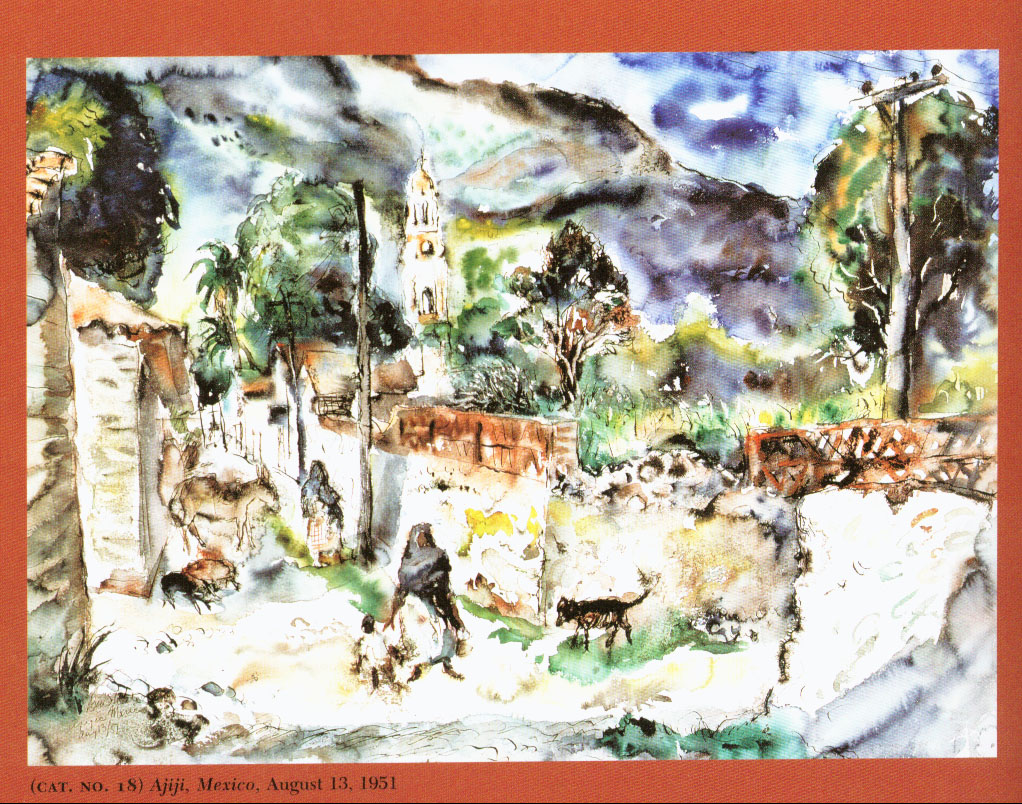
The growing seriousness of art in Atlanta engendered a thriving spirit of adventure with new exhibition opportunities and the development of new private collections. In 1924 the Grand Central Art Galleries of New York, which previously had hosted an exhibition in Macon, held a loan exhibition of paintings and sculpture in Atlanta; another one followed the next year. Haverty was instrumental in bringing these exhibitions to the city. His growing American art collection included works by such well-known artists as William Merritt Chase and Henry Ossawa Tanner. However, art in the state was not without conflict, which drew nationwide attention during these years. After prolonged delays and disagreements among those associated with Borglum’s project on Stone Mountain, a widespread controversy erupted when Borglum was fired in 1925 and Henry Augustus Lukeman was hired to finish work on the Confederate memorial.
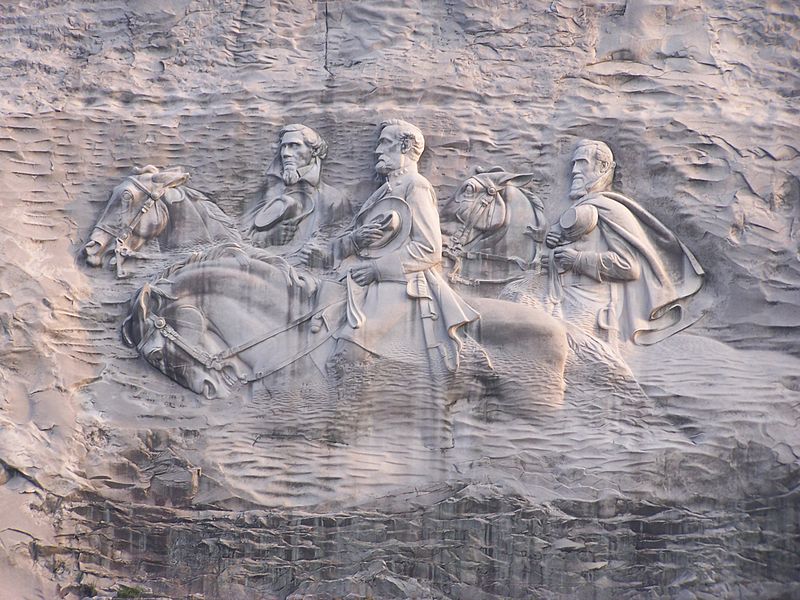
Savannah continued apace in the 1920s as a vibrant art community. The Savannah Art Association, founded in 1920, held art classes and sponsored exhibitions of members’ works at Telfair Academy. Lila Cabaniss, Hattie Saussy, and Emma Wilkins were among many active painters in the city. Visiting artists continued to paint in the city as well. During the period from 1914 to 1920, Jules Pascin, who was associated with such Parisian artists as Marc Chagall, visited the South, including Savannah. American impressionist painter William Chadwick, of the Old Lyme art colony, taught at Telfair Academy in 1925-26. Hilda Belcher, a painter from Vermont and New York, taught and exhibited at the Telfair for many years and was especially admired for her vigorous watercolors. The impressionist New York painter Eliot Clark taught painting in Savannah, beginning in 1922, for the Savannah Art Club and executed thickly applied oils inspired by the picturesque settings of the city and surrounding countryside. Around 1926, the Charleston printmaker Elizabeth O’Neill Verner, working in the etching revival tradition popular at the time, created views of some of Savannah’s historic architecture.
Thomas Hart Benton, the Missouri painter who studied at the Art Institute of Chicago and at the Académie Julian in Paris, traveled in the South during the late 1920s in an attempt to document the overarching themes and cultural conditions of the region for his broad painting project, The American Historical Epic. In the next decade he became a leader and champion of American regionalist painting, an art movement that valued local subject matter and outward observation more than European-based abstraction. His sketches from his trip into Georgia in 1928, part of a tour from Pennsylvania to New Mexico, appeared in a one-person exhibition in 1929 at Delphic Studios in New York.
The 1930s and Early 1940s
The period of the 1930s and early 1940s was rich with discovery for artists in Georgia and engendered what may be termed a “golden age” in the history of painting, drawing, printmaking, and documentary photography in the state. During this decade and a half, as with other cultural areas of expression in the state, art in Georgia demonstrated an interest in the distinctive qualities of the state’s varied land and peoples, in keeping with the nationwide trend toward regionalism. The federal government encouraged this emphasis, commissioning nationally recognized artists to decorate post offices in the state with paintings and sculptures and commissioning photographers to document social conditions in various communities, especially poor, rural ones. All in all, the era was a substantial one for the visual arts in Georgia.
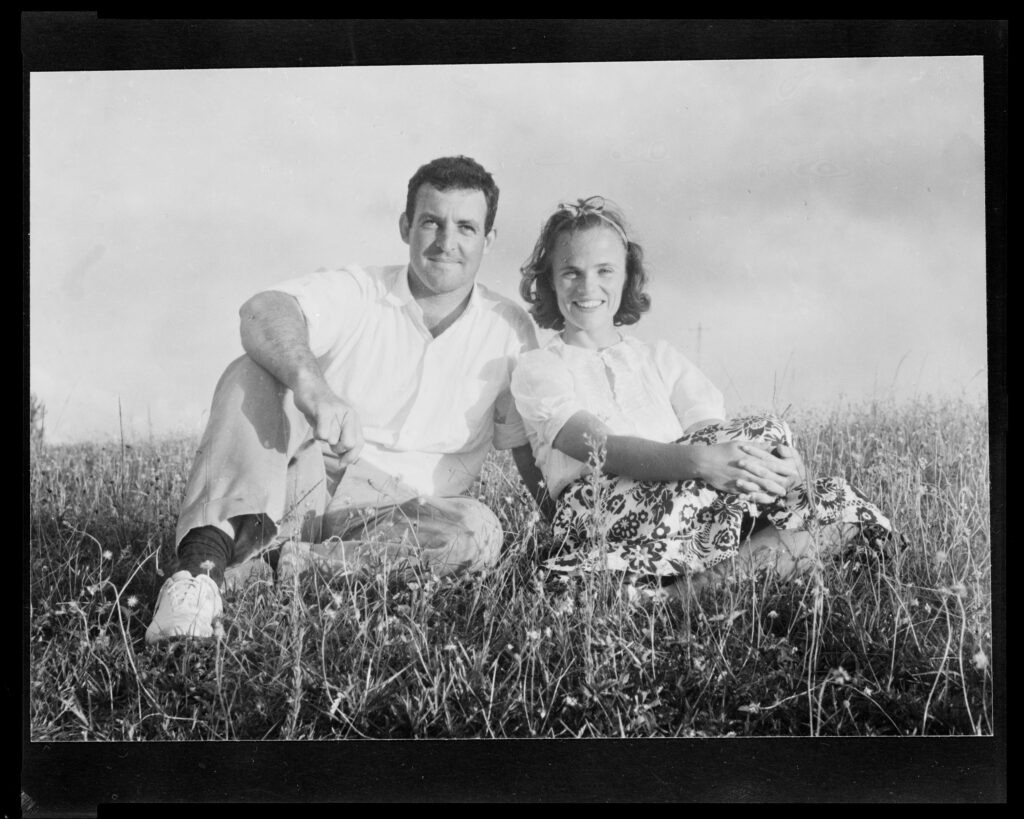
As in the 1920s, new organizations devoted to promoting art in Georgia were established, while outside organizations and visiting artists continued to be attracted to the state. In 1929 the Association of Georgia Artists, affiliated with the Southern States Art League, was founded, and Hattie Saussy served as president in 1933-34. Its first exhibition opened in Savannah and traveled to Atlanta, Macon, Athens, Columbus, and Augusta. In Savannah during the early 1930s, the Telfair worked closely with the American Federation of Arts to bring exhibitions and speakers to the city. Savannah artists also formed the Savannah Art Club. Art exhibitions in Georgia during the 1930s were listed in Art Digest, a champion of the realist American Scene aesthetic that spread throughout the country during the decade.
National Exposure
With national attention directed toward the regions of the country, the South became the focus of much journalistic, social, and cultural inquiry. A rich era of the visual arts ensued among Georgia artists and artists touring the state. Selected sketches from Thomas Hart Benton’s 1928 trip to Georgia—drawings made in the middle and southern parts of the state—were incorporated into his painting Cotton Pickers, Georgia (1931), which was purchased in 1933 by the Metropolitan Museum of Art. These sketches were also incorporated into his America Today murals, made in 1930 for the New School for Social Research in New York, and in his Arts of the South panel for The Arts of Life in America mural series, made for the Whitney Museum of American Art in New York. The sketches also became illustrations in his 1937 autobiography, An Artist in America. In 1932 and 1943 Benton traveled into Georgia again.
Benton’s national prominence and his interest in the rural South helped to promote southern landscapes and cultures as legitimate and popular subject matter for American art in the 1930s. Other artists from outside the state also made tours, including the Belgian-born painter Georges Schreiber, who traveled in Georgia during the latter half of the 1930s, filling sketchbooks with drawings as part of a two-and-a-half-year project to paint different regions of the nation. In the late 1930s, the painter David Fredenthal, trained at the Cranbrook Academy of Art, traveled to Wrens, the hometown of writer Erskine Caldwell, to make unsolicited drawings for a new edition of Caldwell’s popular novel Tobacco Road (1932). Accompanied by Alabama artist Charles Shannon, who made sketches of local sharecroppers on the trip, Fredenthal created his drawings from memory and sent them to Caldwell, who successfully supported their inclusion in a new edition of his novel, published in 1940.
In 1936 Charles Alston, an African American artist from New York, visited Atlanta University (later Clark Atlanta University), where he worked in a studio provided by the school. Previously Alston had studied at Columbia University and worked as an illustrator, as the director of the Carnegie Art Workshop of the New York Public Library at 135th Street, and as a supervisor of the murals at Harlem Hospital, which were sponsored by the Works Progress Administration (WPA). Starting in 1936, Aiden Lassell Ripley, a Massachusetts-born, highly skilled watercolorist trained at the School of the Museum of Fine Arts in Boston under Frank Weston Benson and Philip Leslie Hale, began visiting and painting plantations and hunting areas in Georgia, Florida, and South Carolina. He traveled to the South during winters on trips sponsored by the Sportsman’s Gallery of Art and Books of New York. The Maine watercolor artist and Art Students League teacher Eliot O’Hara taught art at the Telfair Academy and authored numerous books on watercolor techniques. His Georgia Sunset (no date) is housed at the Telfair Museum of Art.
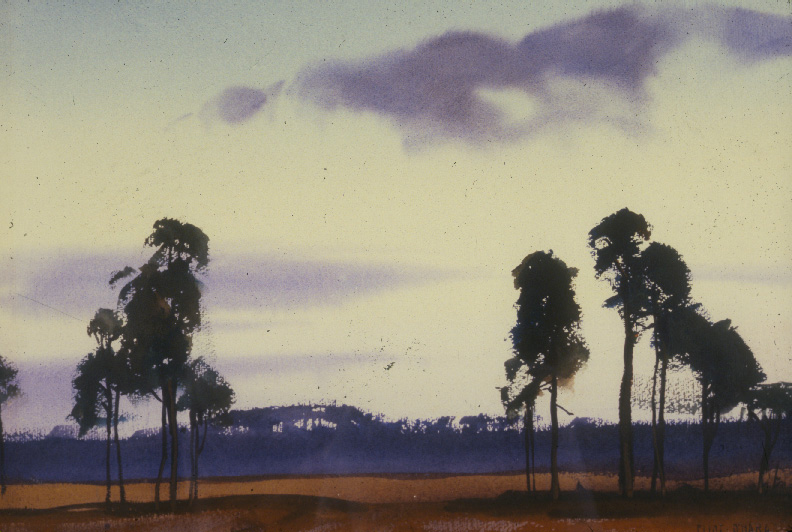
American Scene Movement
Artists who lived in Georgia in the 1930s and 1940s became part of the nationwide American Scene movement, which took fresh, direct approaches to local subject matter. For instance, in 1931 painter Hale Woodruff, reared in Nashville, Tennessee, and trained at the John Herron Art School in Indianapolis, Indiana, returned to the South from study in Paris to head the art department at Atlanta University. He also offered classes in drawing, oils, watercolor, printmaking, and art appreciation to students at Spelman and Morehouse colleges. The sculptor and Rhode Island native Nancy Elizabeth Prophet, encouraged by her friend W. E. B. Du Bois, a professor at Atlanta University, began teaching at Spelman College in 1934. Trained at the Rhode Island School of Design in Providence, she studied sculpture at the Ecole des Beaux-Arts and exhibited to critical acclaim at the salons in Paris, where she lived for twelve years and gained an international reputation for her realistically carved wood and marble portrait heads and life-size statues. Devoted to teaching, she apparently did little of her own work while in Atlanta; she seems to have left the city in 1944 and then lived in New York before returning to Rhode Island.
In 1935 Woodruff organized his art students at Atlanta University into a guild. While there, he also organized student art exhibitions, gave gallery talks, and borrowed traveling exhibitions from such sources as the Harmon Foundation and the Whitney Museum of American Art. In 1942 he instituted the Atlanta University Annual, a national exhibition for Black artists. The rolling land and the social life of the African American South had a strong attraction for Woodruff, which he expressed in vibrant paintings and sometimes critical black-and-white woodblock prints. In 1936 he studied fresco painting in Mexico with muralist Diego Rivera and in 1938-39 created his own mural, Mutiny of the Amistad, for Talladega College in Alabama. Woodruff taught at Atlanta University until the mid-1940s, afterward teaching at New York University. Woodruff and his students became known as the “Atlanta School,” and they created a body of work based on images of African American life and culture in the area. One of his students, Atlanta-born Wilmer Jennings, made several prints of rural southern scenes before devoting his work full-time to jewelry design in Providence, Rhode Island, with the Imperial Pearl Company.
From 1935 through 1942 Lamar Baker, who studied for seven years in New York, came back during the summers to Atlanta and to Waverly Hall, his ancestral home near Columbus. He took his Georgia sketches back to New York, where in 1938 he began a series of prints on the “cotton culture” of the state, completing them in 1941. Baker, who studied with Kenneth Hayes Miller and with social realist painter and printmaker Harry Sternberg at the Art Students League, reacted strongly to this subject, creating works that criticized social conditions for workers, as seen in his Textile Tangle at the Columbus Museum in Columbus. His works also comment on the harrowing threat and reality of lynching.
James Routh, a native of New Orleans, Louisiana, created several lithographs in 1940 based on sketches made that year during a tour of the South, which was supported by a Rosenwald Fund fellowship. One of these lithographs, Mississippi Delta, is housed at the Georgia Museum of Art in Athens. Routh studied at the Art Students League with Sternberg and painter Raphael Soyer, and under the guidance of Will Barnet at the League, he learned how to print lithographs. He and Barnet printed lithographs for both students and established artists alike at the League.
The rhythmic topography and everyday scenes of Georgia also inspired Nell Choate Jones, an artist with a modernist emphasis on color and line in her landscapes and cityscapes. In the 1930s and 1940s she often visited Marietta and Ansley Park near Midtown Atlanta, and she also traveled to Savannah. Born in Hawkinsville in south Georgia, Jones moved with her family to Brooklyn, New York, at a young age. In the late 1920s, critics admired her picturesque landscapes of France and Woodstock, New York; however, in the 1930s her local southern subjects aligned her with the nationwide trend of the American Scene. Jones studied at the Fontainebleau School of Art in France and trained in England and New York. She thrived as a painter and organizer, exhibiting frequently and chairing various art organizations, including the National Association of Women Artists and the Brooklyn Society of Artists. Topography and what she saw as the “picturesqueness” of the land and its peoples—especially African Americans—were the main subjects of her southern paintings, as exemplified in her Georgia Red Clay (1946), which is housed at the Morris Museum of Art. Executed with bold contours and vigorous shapes, her canvases feature muscular roads and trees and a modernist emphasis on color and line.
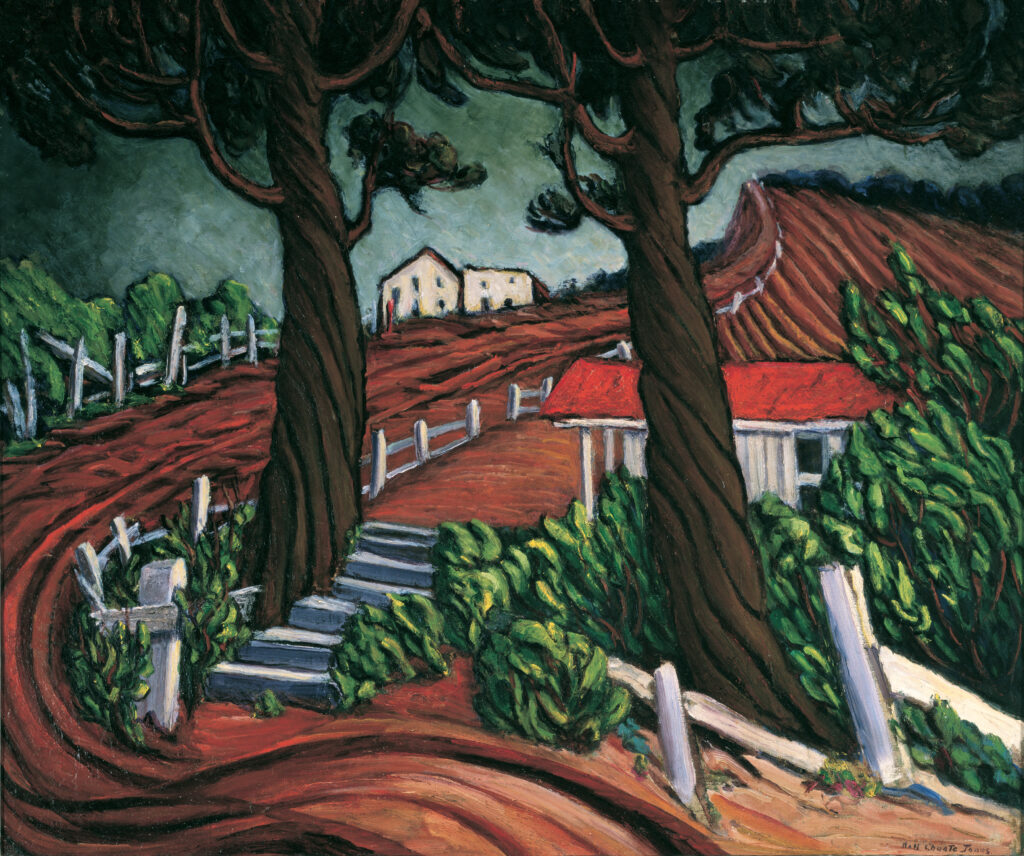
Key Figures
Lamar Dodd, a painter, professor, and administrator born in Fairburn and reared in LaGrange, trained at the Art Students League with well-known artists George Bridgman, Jean Charlot, John Steuart Curry, Richard Lahey, and Boardman Robinson. Dodd started teaching art at the University of Georgia in the fall of 1937 as artist-in-residence and later became chair of the art department, building it extensively through the years and remaining its head until 1973. He gained recognition early on, winning an award for a painting shown at the Art Institute of Chicago in 1936 and exhibiting work in New York and Atlanta. His paintings of the South, especially Alabama, Georgia, and Tennessee, during the 1930s and early 1940s emphasize the forms and lines of the landscape and underscore its evocative atmospheric effects, as seen in his Copperhill (1938), which is on extended loan to the Georgia Museum of Art.
At the University of Georgia, Dodd instituted a program of artists-in-residence that included muralist Jean Charlot, the printmaker and muralist Howard Cook, and the New Yorker illustrator and cartoonist John Held Jr. During his stays, Charlot completed two series of murals for the university. He executed the first one, a three-panel mural symbolizing music, drama, and the visual arts, during 1941-42 for the Fine Arts Building. Charlot also executed a three-panel mural for the Henry Grady School of Journalism in 1943-44, this one set around the themes of U.S. paratroopers landing in Italy, the symbolic figure of Time, and Cortez landing in Mexico. Among Dodd’s students at this time was Reuben Gambrell, who received the first master’s degree in fine arts from the University of Georgia. Gambrell’s early art fit into the American Scene aesthetic of local subject matter painted in a readily understandable style; by the early 1950s, his work evinced a more modernist emphasis on shape and line. He taught at various institutions, including the University of Georgia extension campus at Hunter Army Airfield in Savannah, the University of Georgia, and Telfair Academy.
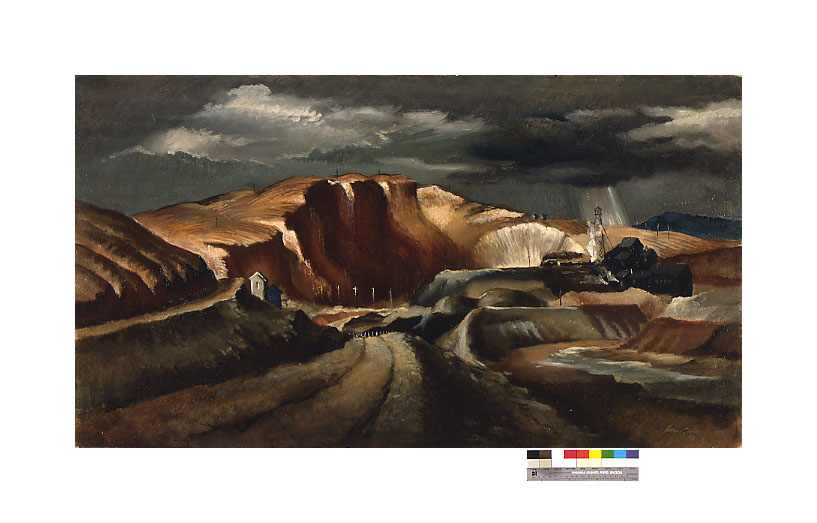
The Ohio artist Howard Thomas joined the faculty of the art department at the University of Georgia in 1945 and was, like Woodruff and Dodd, a painter fascinated by the shapes and contours of the southern landscape. Trained at the School of the Art Institute of Chicago, he recorded observations from his many travels in vivid sketchbooks, which are housed in the permanent collection of the Georgia Museum of Art. Thomas retired in 1965.
In 1942 the German expatriate painter Emil Holzhauer, who studied with the New York realist painter Robert Henri, settled in Macon and taught art at Wesleyan College. In 1950 he began teaching summer art sessions in Savannah at the Telfair school, and he eventually settled in Niceville, Florida. Holzhauer’s watercolors, pastels, and oils present the American local landscapes and cityscapes, portraits, and interiors through an emphasis on color and line learned from postimpressionism, as exemplified in Church Spires (1944), housed at the Museum of Arts and Sciences in Macon.
Around 1937-38, the New York figurative and landscape artist Alexander Brook moved to Savannah and spent a few years there, splitting his time between Savannah and New York. In 1944 he returned to Savannah but finally settled in Sag Harbor, New York, in 1948. His painting Georgia Jungle (1939), a desolate, rain-soaked scene of Tin City, an African American community near Savannah, won first prize in 1939 at the Carnegie International Exhibition, gaining national attention.
Brook often portrayed the dramatic visual effects that impoverishment brought to the southern land and its architecture. Trained at the Art Students League and associated with the Whitney Studio Club in New York (later the Whitney Museum of American Art), Brook was part of a thriving circle of artists in New York City and at the artist’s colony at Woodstock, one hundred miles north of Manhattan. In Savannah he participated in classes taught by Gambrell at the University of Georgia campus extension, giving demonstrations and critiques. He attracted to Savannah numerous artists and was a vital part of the artistic social life there. An art colony formed along Factor’s Walk in the waterfront district where he had his home, and nearby towns Bluffton and Beaufort, both in South Carolina, attracted artists as well.
Brook and the painters Arnold Blanch; Henry Lee McFee, who had first come to Savannah in 1936; Andrée Ruellan; and John Taylor, all from the Woodstock area, visited and worked in and near Savannah during this period. Representative works include McFee’s A Grove, Savannah, and Ruellan’s City Market, Savannah (1942). Painter William Halsey of Charleston, South Carolina, lived in Savannah from 1942 to 1945 and directed the art school at Telfair Academy during that time. While there, he painted in a lyrical, expressionist style, capturing scenes along Savannah’s streets.
In nearby St. Marys, the miniature painter Pamela Hart Vinton Ravenel of Massachusetts became prominent in the 1930s. She lived part of the year in Woodstock, New York. Trained at the Maryland Institute in Baltimore and then in Paris, Ravenel became especially known in the 1930s for her informal, often humorous portraits painted in a straightforward manner.
A number of native Savannah artists were active as well during the 1930s and early 1940s. Christopher Murphy Jr., the son of Christopher P. H. Murphy, trained at the Art Students League under etcher Joseph Pennell and at the Beaux Arts Institute in New York and thrived with a body of elegant paintings, drawings, and etchings of Savannah and coastal scenery. His sister, painter Margaret Augusta Murphy, trained with her parents and brother and with Dodd at the University of Georgia, where she received a bachelor’s degree in art in 1942. Her Street Scene, Savannah (ca. 1930-1940) is housed at the Morris Museum of Art. She regarded as highly inspirational her experiences of studying art in New York at the Pratt Institute and with visiting artists, followed by a summer touring Europe. A painter of landscapes and still lifes, she taught art in the Savannah public schools as well as at colleges, including Armstrong College (later Armstrong State University) in Savannah, Mercer University in Macon, and South Georgia Teachers College (later Georgia Southern University) in Statesboro.
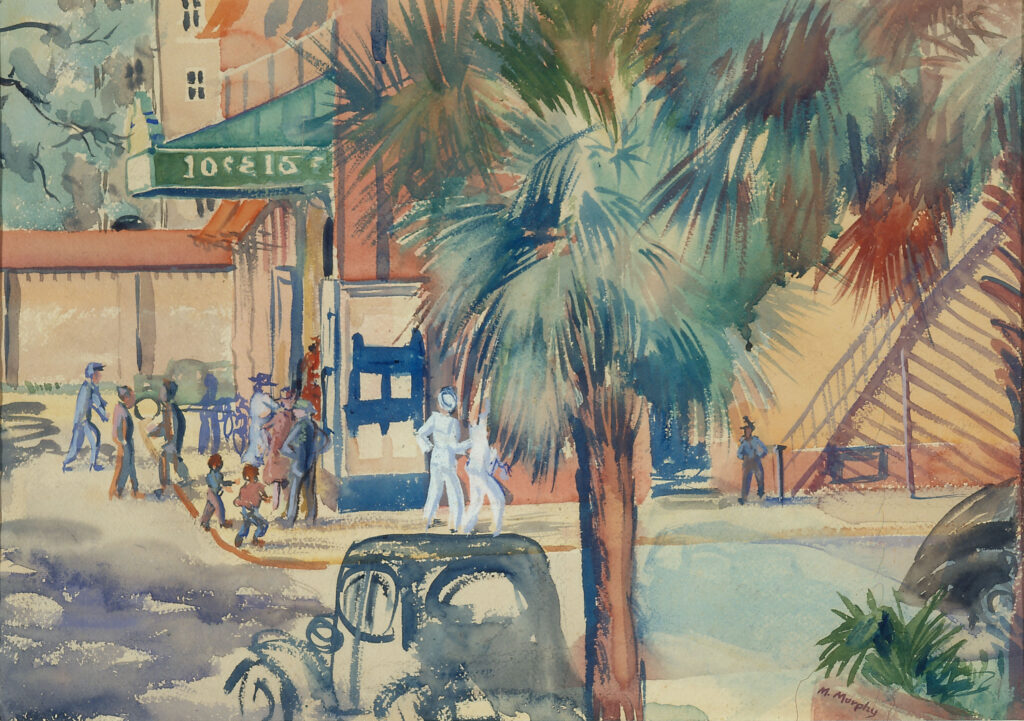
Another Savannah artist, Augusta Oelschig, established a studio in the city at Factor’s Walk. She studied first with Emma Cheves Wilkins in Savannah, then with Dodd at the University of Georgia from 1937 to 1939, and lastly with McFee in Savannah. In 1948 she moved to New York but returned to Savannah around 1961. Oelschig painted vigorous everyday scenes of Savannah and the Lowcountry with prominent images of African Americans, including her Untitled [Market] (ca. early 1950s), which is part of the collection at the Telfair Museum of Art. Her work in the late 1940s, after her contact with the politically charged Mexican muralists, especially Jose Clemente Orozco, included critical drawings commenting on racism and lynching in the South. She proposed, but never completed, a mural for Savannah High School.
Traditional Arts
In Savannah and the Lowcountry of Georgia and South Carolina, a legacy of decorative art among African Americans, including carvings, canes, quilts, baskets, furniture, and grave decorations, continued into the early twentieth century. During the 1930s and early 1940s, a period in which regional cultures were emphasized in literature, music, and the arts, the less conventional works of southern, self-taught artists, especially African Americans, were exposed to a wider audience and received greater appreciation. Trained artists in the Savannah area often collected the work of self-taught artists. Collectors included Alexander Brook, who acquired work by William Edmonson of Nashville, and Arnold and Lucille Blanch.
The graveyard sculptures of Siras Bowen, of Sunbury, and carvings by other African Americans, including Jerome Carter, of Frogtown, and James “Stick Daddy” Cooper, of Port Wentworth, were reproduced in the book Drums and Shadows: Survival Studies among the Georgia Coastal Negroes. Drums and Shadows, published in 1940 by the Georgia Writers’ Project of the WPA, also features photographs by Savannah natives Malcolm Bell Jr. and Muriel Barrow Bell.
A politician, carpenter, and graduate of Atlanta University, William Rogers of Darien carved animals and walking sticks, wooden spoons, and other objects in an African-influenced tradition. His carving Staff is housed as the Columbus Museum. Ulysses Davis of Fitzgerald made his earliest carved figures at the age of twelve; in 1942 he moved to Savannah, where he worked on his distinctive carvings of Abraham Lincoln, animals, and other objects at night. More than two hundred carvings by Davis are preserved in Savannah at the Beach Institute African American Cultural Center, including his Mary on Donkey. In the 1930s William O. Golding, a Savannah-born African American and world-traveling seaman for about fifty years, made around sixty bold line drawings in pencil and crayon while convalescing at the Marine Hospital in Savannah. His work, which depicts his memories of ships, their crewmen, and scenic ports, was encouraged by Margaret Stiles, the recreation director at the hospital and an artist-member of the Savannah Art Club.
The white, self-taught artist Carleton Garrett of Flowery Branch, in north Georgia, began carving dolls for his daughters in 1940. He later produced whimsical, moving scenes, including a parade, church meeting, and hospital, but stopped carving in 1962 when he retired from Mooney Furniture Company. His Car Parade is housed at the High Museum of Art in Atlanta.
Federally Sponsored Art
In the 1930s and early 1940s, many artists worked for the federal government under U.S. president Franklin D. Roosevelt’s New Deal policies, which created employment for out-of-work Americans during the bleak years of the Great Depression. The Public Works of Art Project (PWAP) concentrated early attention on the decoration of municipal and state buildings. Hale Woodruff, for instance, made a mural, The Negro in Modern American Life, for David T. Howard Junior High School in Atlanta. Dox Thrash, born in Griffin and trained at the School of the Art Institute of Chicago, worked in the WPA’s Graphic Arts Division in Philadelphia and is attributed with founding the Carborundum etching, a new print medium.
Another federal government program, the Section of Painting and Sculpture (later the Section of Fine Arts), under the U.S. Treasury Department, sponsored the decoration of 1,100 post offices throughout the country from 1934 to 1943. Nationally known artists, including painters Peter Blume, Philip Evergood, Philip Guston, and Doris Lee created post office murals or sculptural reliefs for Georgia. Under this program, art was produced for post offices in the cities of Adel, Ashburn, Augusta, Blakely, Cairo, Camilla, Cochran, College Park, Commerce, Conyers, Cornelia, Cuthbert, Decatur, Eastman, Gainesville, Greensboro, Hartwell, Jackson, Jesup, Lawrenceville, Louisville, Lyons, Manchester, McDonough, McRae, Monticello, Pelham, Rockmart, Rome, Summerville, Swainsboro, Sylvania, Sylvester, Vidalia, Warrenton, Winder, and Wrightsville. Selected most often through competitions overseen by townspeople, artists tended to portray contemporary workers, panoramas of the countryside or town, and historical scenes unique to the locale. Generally trained in such large art centers as New York and Philadelphia, these painters and sculptors were familiar with the leading art movement of the time, American Scene realism, which the program promoted. Today many of these works made for Georgia sites remain in their original locations, although some works have been moved, and one has been destroyed.
In other examples of public art, husband and wife William Hoffmann and Martina Steere painted a mural (circa 1934), depicting Robin Hood before the queen’s court, for the Savannah public library’s main branch on Bull Street. In 1943 the U.S. government put on permanent loan to the University of Georgia paintings, drawings, and prints produced under WPA patronage during the 1930s and early 1940s. Other institutions in Georgia that received WPA allocations of art were Georgia College (later Georgia College and State University ) in Milledgeville, Georgia Southern College, the Macon public schools, and West Georgia College (later the University of West Georgia) in Carrollton.
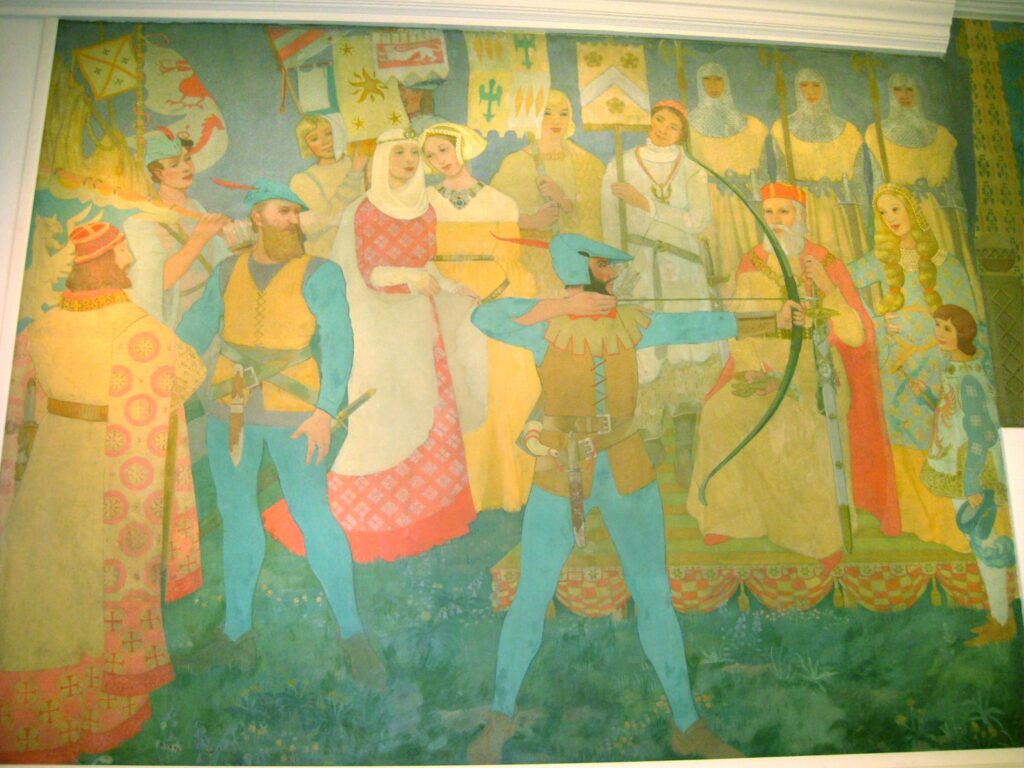
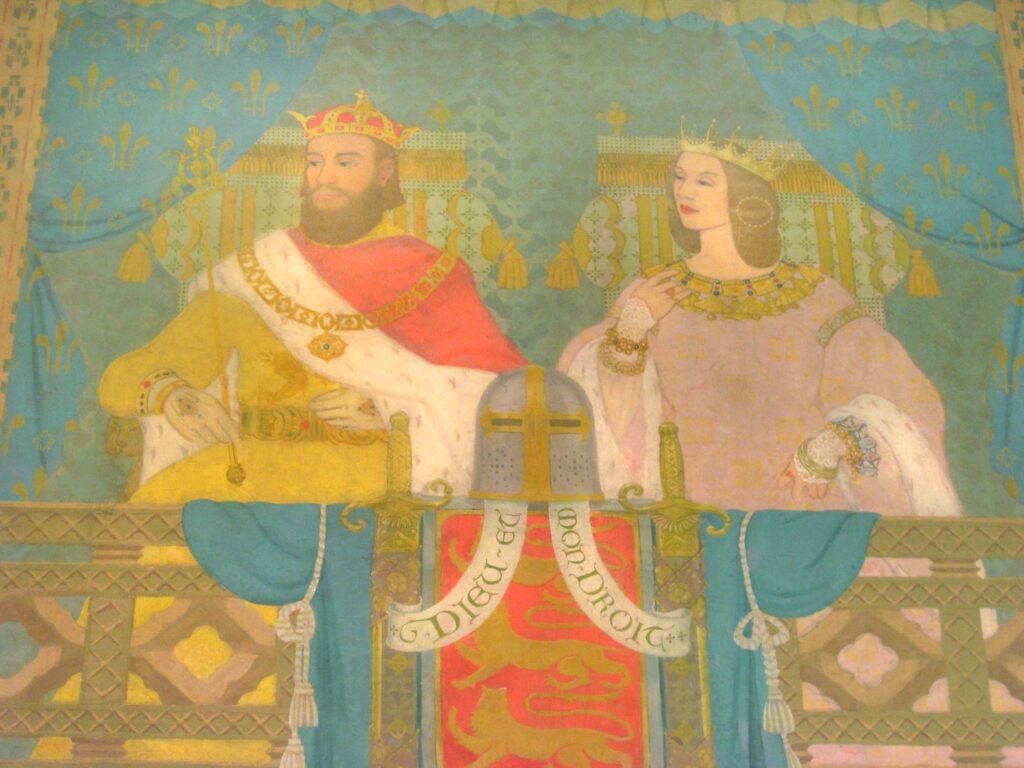
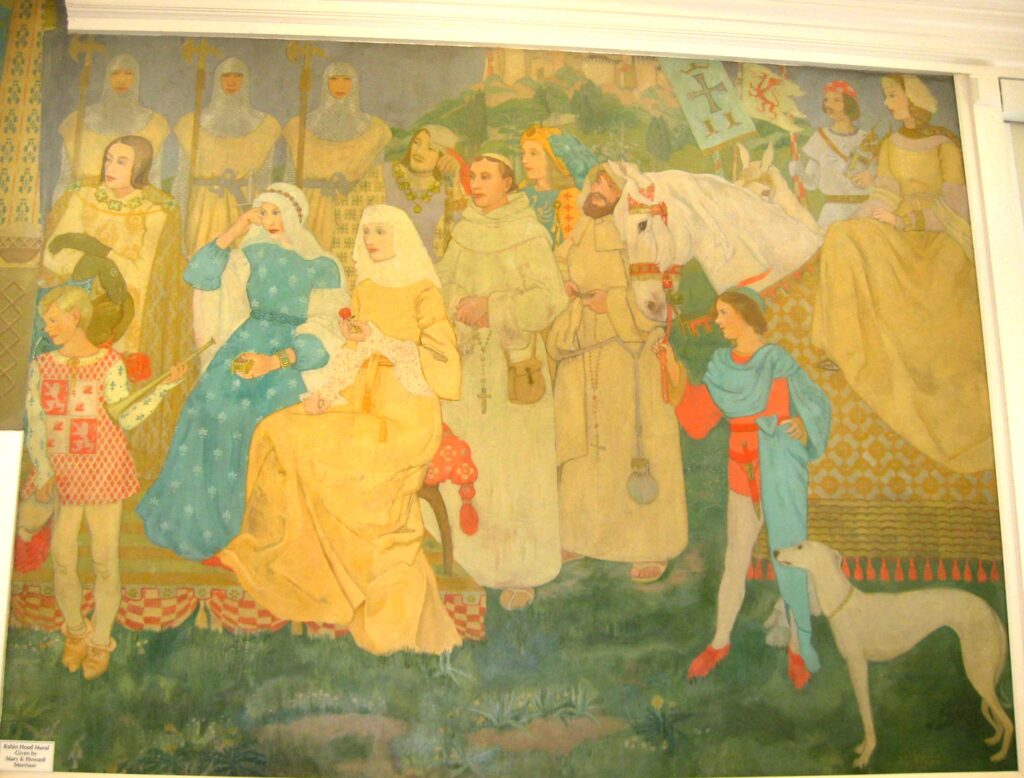
Photography
Photographers employed by the New Deal’s Farm Security Administration (1935-43) documented living conditions across the country, especially those in destitute areas. Photographers recording scenes in Georgia included Jack Delano, Walker Evans, Dorothea Lange, Carl Mydans, Ben Shahn, John Vachon, and Marion Post Wolcott. In February 1935 Evans made photographs on the Hermitage Plantation in Savannah. In March 1936 he shot photographs of a Black community in Atlanta, an abandoned plantation house in Monticello, ruins of tabby-constructed architecture in St. Marys, Main Street in Macon, and new housing construction in Eatonton. (These images and others are included in the prints and photographs catalog of the Library of Congress.) Delano, Lange, and Post Wolcott photographed scenes in Greene County. Delano, accompanied by sociologist Arthur F. Raper, made a body of prints there in the early 1940s. He also photographed living conditions in Heard and Carroll counties.
As part of the nationwide trend for documentary photography, numerous photographers traveled through Georgia during these years, recording living conditions as well as local crafts, industry, and scenery. For instance, around 1933-34, Doris Ulmann visited Georgia and the surrounding region to photograph Appalachian artisans. These images, including Jason Reed, North Georgia Chairmaker (ca. 1933-34), were used to illustrate the book Handicrafts of the Southern Highlands (1937) by Allen H. Eaton. In 1937 the book You Have Seen Their Faces was published with text by writer Erskine Caldwell and photographs by Margaret Bourke-White. The two had traveled from Augusta, where Caldwell’s parents lived, to Arkansas, documenting sharecroppers and others along the way. Bourke-White, with stark black-and-white clarity, also made photographs in 1939 related to the pine-tree paper industry in Savannah for a photo-essay in Life magazine titled “Life Goes to a Paper Festival at Savannah.” She also photographed economically poor sections of Savannah. In 1941 Edward Weston traveled to Savannah and photographed Bonaventure Cemetery; his resulting photograph, Bonaventure Cemetery, Savannah, became an illustration in the Limited Editions Club version of Walt Whitman’s Leaves of Grass, published in 1942.
From the Mid-1940s to 1960
For many artists in the state, the period from the mid-1940s to 1960 marked a gradual transition in the style of their work, generally from scenes of local people and places to a more inward, introspective art that focused on the artists’ feelings toward such broader, universal subjects or ideas as nature. Many artists moved away from the specific picturing of things as one observes them in the world to focus instead on the quintessential shapes, colors, and moods that a place projects, all indicated by an intense handling of paint. This change stemmed in part from the enormously important movement of abstract expressionism coming out of New York. Both Lamar Dodd and Howard Thomas moved in this direction, as did George Cress, Dodd’s student and fellow faculty member at the University of Georgia. Cress went on to become a longtime member of the art faculty at the University of Tennessee in Chattanooga.
During the 1950s, Dodd chose abstraction as his major way of working, and the “subjects” of his oils from that decade stem from an enduring attraction to forms, lines, and textures found in both nature and the city. Similarly Thomas, by the 1950s, was searching for the “big rhythmicorder” in nature by focusing on abstract paintings imbued with natural earth pigments. Likewise Alma Thomas, a native of Columbus and an art teacher in the Washington, D.C., school system, had begun painting her bold expressionist abstractions of hovering, saturated colors by the late 1950s. Earlier, around 1948, Pat Passlof, a native of Brunswick, traveled to Black Mountain College in North Carolina to meet abstract painter Willem de Kooning; afterward, she studied with him in New York and evolved her own abstract expressionist works, imbued with distinctive patterns.
Other artists with Georgia connections during this later period either borrowed elements of abstraction or persisted in visions and styles that honed to more understandable representations of the material world. In 1950 Hale Woodruff, teaching then at New York University, was appointed to paint a six-part mural for the library at Atlanta University, eventually entitled Art of the Negro. The series boasts symbolic shapes and figures amid interlocking color-shapes; indeed, Woodruff’s figures of artists in the panel Muses (1950-51) emerge from bands of semi-abstract fields and ribbons of color. The mural is housed today at the Clark Atlanta University Art Galleries. The Atlanta University Annuals, which Woodruff began in 1942, continued until 1970 and fostered the growth of an art audience among African American communities, the development of generations of Black artists, and an awareness of their work among white audiences.
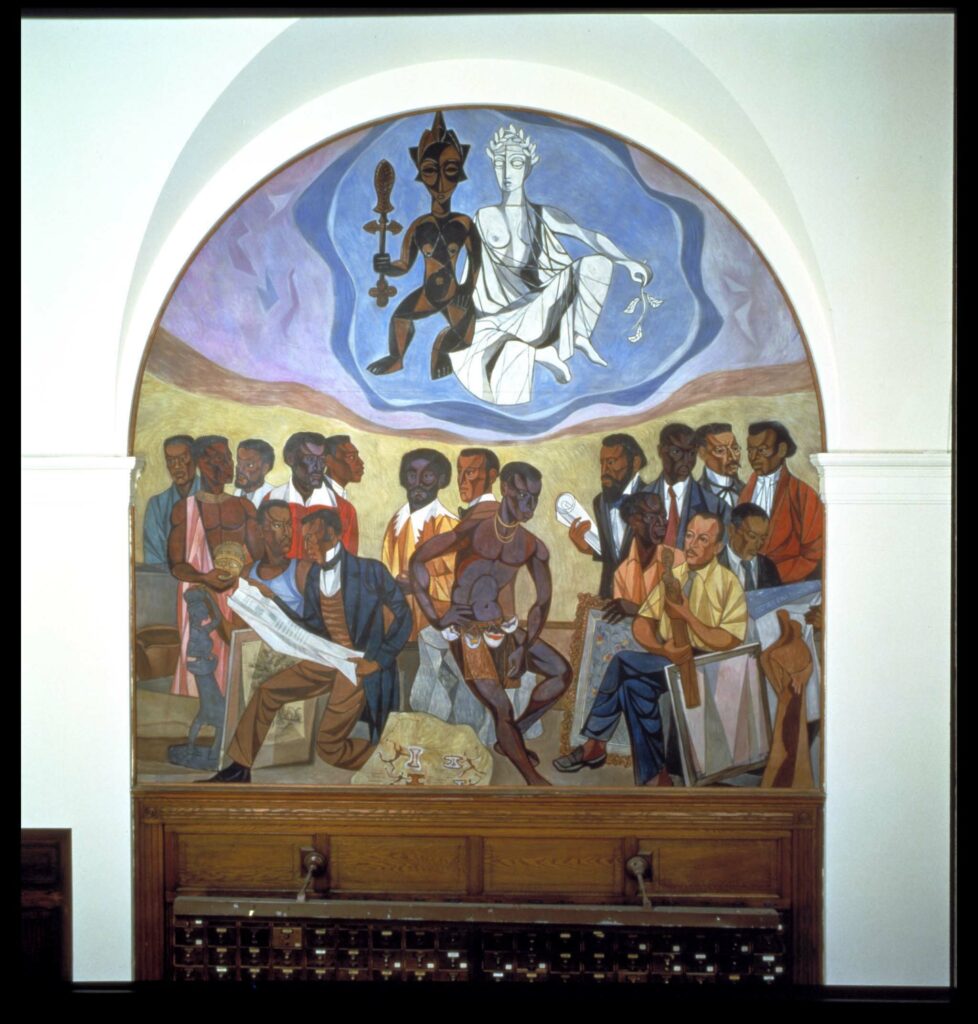
During this period, Jewel Simon, a self-taught artist in Atlanta who participated in the Atlanta University Annuals, painted straightforward landscapes, sculpted, and designed clothes. From Brooklyn, with training from Pratt Institute, New York University, and the National Academy of Design, Walter A. Simon taught art at Savannah State College (later Savannah State University) in the 1940s, creating two large canvases painted in semi-abstract fashion with themes on school activities. Later he taught at Atlanta University, Georgia State University, Paterson State College in New Jersey, and elsewhere and became known for his abstract paintings.
Painter, printmaker, and writer Phillip J. Hampton, who in his later years taught at Southern Illinois University, taught art from 1952 to 1969 at Savannah State College, creating exhibitions of African American art and participating in the National Conference of Artists, which formed in 1957 in Atlanta to encourage Black artists and their work. Born in Missouri, he received degrees at the Kansas City Art Institute in Missouri and went on to work in several different media, including watercolor, gouache, prints, and acrylics. In the 1950s his works included Savannah scenes painted in highly contrasting, sun-drenched colors.
Anna Hunter, the art reviewer for the Savannah News-Press, began painting in the late 1940s, executing scenes of life on local farms and along waterfronts in a vigorous style that accented textures. Her Recessional (1948-50) is housed at the Telfair Museum of Art. She studied under Holzhauer, Gambrell at the University of Georgia extension campus, and Oelschig at the Telfair. Myrtle Jones, born in Forsyth County and reared in Winder, moved to Savannah in the 1940s and became well known in the community for her figurative oils and landscapes brushed with saturated colors in loose, sweeping strokes. In 1957 Paul Goadby Stone, a graduate of Phillips Academy and Harvard University with training at the School of the Museum of Fine Arts at Boston, moved to Savannah and through his work there further embellished his reputation as a painter revered for a high degree of academic finish.
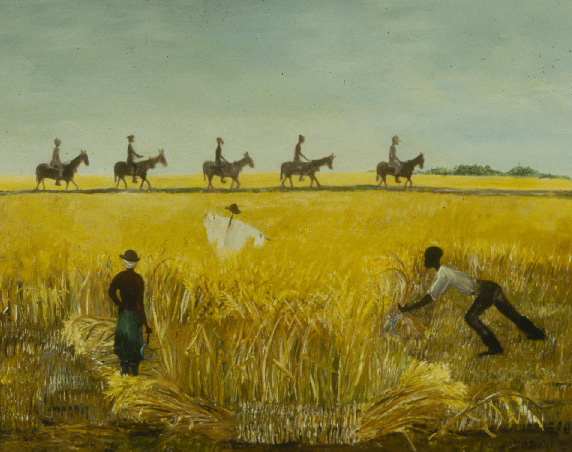
Benny Andrews, from Plainview in middle Georgia, studied at Fort Valley State College (later Fort Valley State University) and, after four years in the Air Force, went on to earn his B.F.A. from the Art Institute of Chicago in 1958. From Chicago he went to New York, where he became recognized as a serious artist and developed collage paintings and line drawings based on memories and observed scenes. Andrews came from a family where freedom of expression was essential; his father, George Andrews, was a self-taught artist who began to paint colorful dots on rocks in the late 1950s, becoming known as the “Dot Man,” in addition to making drawings and other works
Other artists joined the commercial world during these years. Lamar Baker, for example, moved in 1952 to Columbus, where he found work as a designer and draftsman for the Litho-Krome Company, a position he held until 1977. The little-known Augustus I. Riedel of Savannah, the advertising artist for the Central of Georgia Railway, retired in 1953 after having created well-known designs for the Nancy Hanks II and Man o’ War lines. During and after his years with the railroad, he executed charming paintings, usually in watercolor, of buildings in and around Savannah and of local scenes harking back to the late nineteenth century. He also painted a few religious subjects in his later years.
More self-taught artists emerged in Georgia during this period. For example, Nellie Mae Rowe, who lived in Vinings, a suburb of Atlanta, decorated her yard with found objects and artificial flowers and made evocative drawings and paintings in a flat and colorful style drawn from memory or imagination. She also created doll assemblages and sculptures made of used chewing gum and decorated with bright colors. In south Georgia, Eddie Owens Martin, who called himself St. EOM, settled around 1957 in Marion County on inherited land and commenced to build Pasaquan, a complex of concrete buildings and structures with fantastically painted abstract decorations.
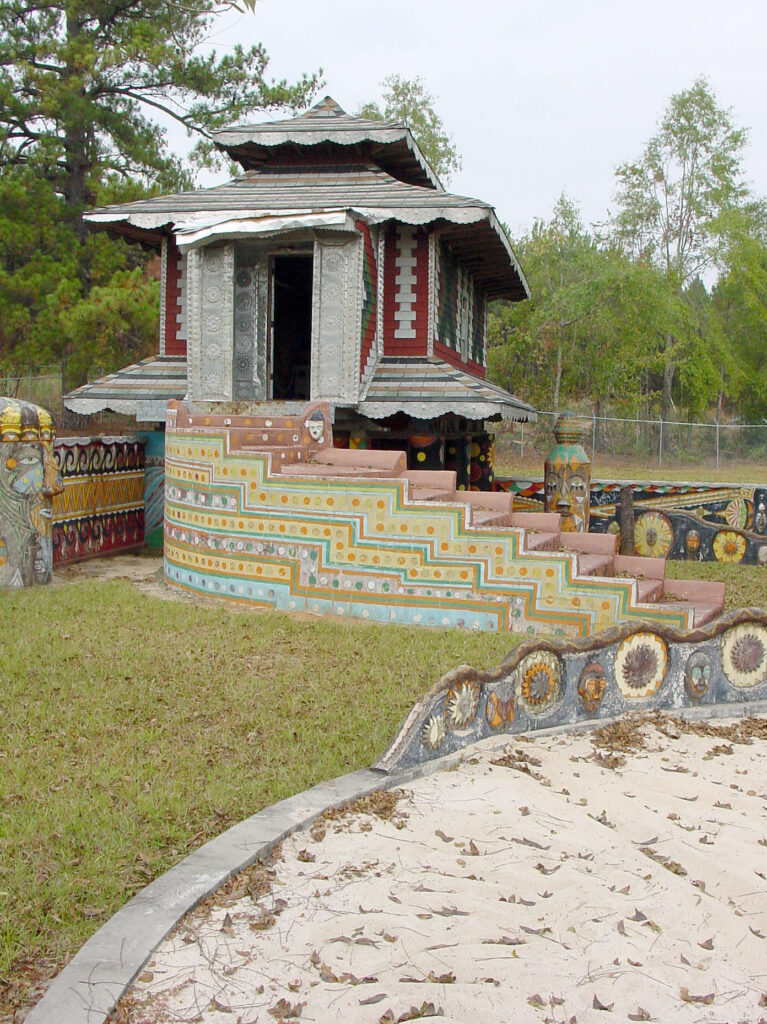
The evolution of the arts in Georgia from the mid-1940s to 1960 laid the foundation for the state’s current activity in the contemporary art world. The growing acceptance of alternative art forms and the transition of the state’s leading artists from representational to abstract styles during this era paved the way for the arrival of major exhibitions, commercial galleries, academic art departments, and new museums in Georgia in the years after 1960.


